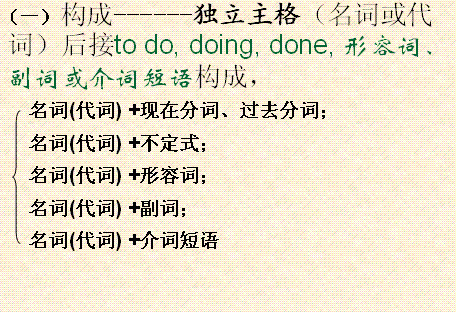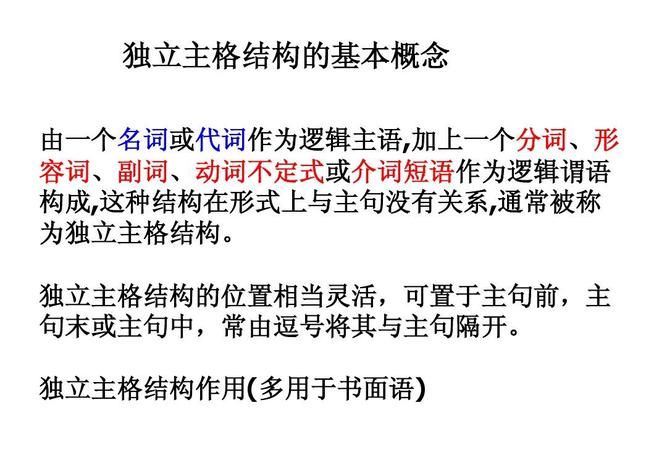本文目录
独立主格结构经典例句作文
独立主格结构经典例句如下:
1、“名词/代词+不定式”结构:由不定式构成的独立主格 结构往往表示还未发生的动作或状态,在句中常作原因状语,偶尔作条件状语。
His friends to come tonight,he is busy preparing the dinner.
他的朋友今晚要来,他正忙着准备晚餐。
2、“名词/代词+现在分词”结构:现在分词表示前面的名词或代词主动进行的动作或状态等。“独立结构”中的being或 having been有时可以省去,这样就成了无动词分句或过去分词分句。
The man lay there, his hands trembling.
那个男子躺在那儿,双手在颤抖。
3、“名词/代词+过去分词”结构:过去分词表示前面的名词或代词被动完成的动作或所处的一种状态。
he boy lay on his back,his hands crossed under his head.
男孩仰卧着,双手交叉放在头下。

独立主格结构的特点:
1、独立主格结构的逻辑主语与句子的主语不同,它独立存在。
2、名词或代词与后面的分词、形容词、不定式、介词等是主谓关系。
3、独立主格结构一般有逗号与主句分开。
独立主格结构主要用于描绘性文字中,其作用相当于一个状语从句,常用来表示时间、原因、条件、行为方式或伴随情况等。
独立主格的用法
独立主格结构是一个独立主格的名词或代词(作为逻辑主格),加上一个分词、形容词、副词、不定式、介词短语。其作用相当于状语,多用来表示行为、方式或伴随的情况,有时也用来表示时间和条件。这种结构多用在书面语中。
一、几种常见的独立主格结构形式
1.名词(或代词)+现在分词(或过去分词)。如:
1)The moon appearing,they decided to go on with theirjouney.
2)Good-bye said,he went home.
2.名词(或代词)+形容词。如:
3)The weather(being)hot,we all went swimming.
3.名词(或代词)+不定式。如:
4)Some of the money to be paid by the thief, the policewent.
4.名词(或代词)+介词短语。如:
5)He climbed in,sword in hand.
5.名词(或代词)+副词。如:
6)The meeting(being)over, we left the room.
独立主格结构的模式是:
主格名词/代词 + 分词/形容词/副词/不定式/介词短语
(作逻辑主语) (作逻辑谓语)
1. All our savings gone, we started looking for jobs.
2. The question settled, we went home.
3. The river having risen in the night, the crossing was impossible.
主格名词/代词 + 分词 (过去分词/现在分词)
主格名词/代词 + 形容词
1. His mother being ill, he had to stay home to look after her.
2. Other things being equal, I would buy the black dress.
主格名词/代词 + 副词
The meeting being over, our headmaster soon left
the meeting-room.
We to care for the children, you are able to be carefree
away from home.
主格名词/代词 + 不定式
主格名词/代词 +介词短语
Our English teacher came into the classroom, papers in hand.
with复合结构 与 独立主格结构
它们都可以在句中作原因状语,伴随状况状语,条件状语,时间状语或结果状语用,一般也可以相互转换.虽然它们的语法功能和意义相同,但其结构形式和名称却不相同.
with复合结构的模式是:
with+名词/代词+分词/形容词/副词/不定式/介词短语
独立主格结构的模式是:
主格名词/代词+分词/形容词/副词/不定式/介词短语
一,作时间状语
1,With winter coming on, the trees turn yellow and
some birds fly south.
=Winter coming on, the trees turn yellow and some
birds fly south.
二,作原因状语
1,With the weather terribly cold, we entered the
room to warm ourselves.
= The weather terribly cold, we entered the room to warm ourselves.
2,With the key having been lost, she could not
enter the room.
= The key having been lost, she could not enter the room.
三,作条件状语
1,With time permitting, we'll visit the Summer Palace.
= Time permitting, we'll visit the Summer Palace.
2,With the car going wrong, we'll have to stop
at the foot of the mountain.
= The car going wrong, we'll have to stop at the foot
of the mountain.
四,作伴随状语
1,The mother was cleaning the house with her baby
playing on the bed.
=The mother was cleaning the house, her baby playing
on the bed.
2,Last night I followed him, with a sword in my hand.
= Last night I followed him , sword in hand.
无论with复合结构还是独立主格结构,都不可有动词的谓语形式充当其中的逻辑谓语.如下例中的was就必须去掉:
He sat at the desk reading
with a pen was in his right hand.
with复合结构可以作后置定语修饰名词,而独立主格结构则不可作后置定语修饰名词.
Soon she arrived at a park with grass green and
flowers in blossom.
= Soon she arrived at a park whose grass was green
and whose flowers were in blossom.

独立主格结构的八种形式
一、独立主格结构基本构成形式 名词(代词)+现在分词(过去分词;形容词;副词;不定式;名词;介词短语) 1. 名词(代词)+现在分词Night enshrouding the earth, nobody could make out what the dark mass was from a distance.黑夜笼罩大地,谁也看不清远处黑压压的一片是什么东西。There being no bus, we had to walk home. 由于没有公共汽车,我们只好走回家。 2. 名词(代词)+过去分词The workers worked still harder, their living conditions greatly improved. 由于工人们的生活条件大大提高,他们工作得更起劲了。He was listening attentively in class, his eyes fixed on the blackboard. 他上课专心听讲,眼睛紧盯着黑板。 3. 名词(代词)+不定式在“名词/代词+动词不定式”结构中,动词不定式和它前面的名词或代词如果存在着逻辑上的主谓关系,动词不定式则用主动的形式;如果是动宾关系,则用被动形式。The four of us agreed on a division of labor, each to translate a quarter of the book. 我们四人同意分工干,每人翻译全书的四分之一。Many trees, flowers, and grass to be planted, our newly-built school will look even more beautiful. 种上许多的树、花和草后,我们新建的学校看上去将更美。 4. 名词(代词)+形容词The Trojans asleep, the Greek soldiers crept out of the hollow wooden horse.特洛伊人睡着了,于是希腊士兵从中空的木马里悄悄爬了出来。Computers very small, we can use them widely. 电脑虽小,我们却能广泛地利用它们。 5. 名词(代词)+副词The meeting over, our headmaster soon left the meeting room. 散会了,校长很快就离开了会议室。The lights off, we could not go on with the work. 灯熄了,我们不能继续工作了。 6. 名词(代词)+名词His first shot failure,he fired again.他第一枪没击中,又打了一枪。Two hundred people died in the accident, many of them children. 两百人死于事故,其中有许多儿童。 7. 名词(代词) +介词短语He lay at full length upon his stomach,his head resting upon his left forearm.他的脊背朝天,四肢伸展,头枕着左臂,直挺挺地趴伏着。Every afternoon a very old woman hobbled past the old house,a vast load of firewood on her back.每天下午,一个背着一大背柴禾的老妇人都会从那间破旧的房屋前蹒跚着走过。 二、with,without 引导的独立主格结构 with ( without)+宾语(名词/代词)+宾语补足语,宾语通常由名词或代词充当,但代词一定要用宾格。上文的独立主格结构的几种情况都适用于此结构。 The girl hid her box without anyone knowing where it was. 小女孩把盒子藏了起来,没有人知道它在哪里。(without +名词/代词+动词的-ing形式) Without a word more spoken, she left the meeting room. 她没再说什么话就离开了会议室。(without+名词/代词+动词的-ed形式) The kid feels excited with so many places of interest to visit. 有这么多的名胜可参观,小孩很激动。(with+名词/代词+动词不定式) The boy was walking, with his father ahead. 父亲在前,小孩在后走着。(with+名词/代词+副词) He stood at the door, with a computer in his hand. 或He stood at the door, computer in hand. 他站在门口,手里拿着一部电脑。(with+名词/代词+介词短语) With his son so disappointing, the old man felt unhappy. 由于儿子如此令人失望,老人感到很不快乐。(with+名词/代词+形容词)在with (without) 的复合结构中,多数情况下with 能省略,但without 不能省略。

独立主格结构经典例句作文
独立主格结构经典例句有以下:
1、名词(代词)+现在分词
Night enshrouding the earth, nobody could make out what the dark mass was from a distance.
黑夜笼罩大地,谁也看不清远处黑压压的一片是什么东西。
2、名词(代词)+过去分词
The workers worked still harder, their living conditions greatly improved.
由于工人们的生活条件大大提高,他们工作得更起劲了。
3、名词(代词)+不定式
在“名词/代词+动词不定式”结构中,动词不定式和它前面的名词或代词如果存在着逻辑上的主谓关系,动词不定式则用主动的形式;如果是动宾关系,则用被动形式。
The four of us agreed on a division of labor, each to translate a quarter of the book.
我们四人同意分工干,每人翻译全书的四分之一。
4、名词(代词)+形容词
The Trojans asleep, the Greek soldiers crept out of the hollow wooden horse.特洛伊人睡着了,于是希腊士兵从中空的木马里悄悄爬了出来。
5、名词(代词)+副词
The meeting over, our headmaster soon left the meeting room.
散会了,校长很快就离开了会议室。
6、名词(代词)+名词
His first shot failure,he fired again.
他第一枪没击中,又打了一枪。
7、名词(代词) +介词短语
He lay at full length upon his stomach,his head resting upon his left forearm.
他的脊背朝天,四肢伸展,头枕着左臂,直挺挺地趴伏着。

需知:
独立主格结构主要用于描绘性文字中,其作用相当于一个状语从句,常用来表示时间、原因、条件、行为方式或伴随情况等。例如:
表示时间
The meeting being over, all of us went home. 开完会后我们都回家了。
Her work done, she sat down for a cup of tea. 她干完了活,坐下来喝茶。
以上就是关于独立主格结构8种基本句型 ,独立主格结构经典例句作文的全部内容,以及独立主格结构8种基本句型 的相关内容,希望能够帮到您。
